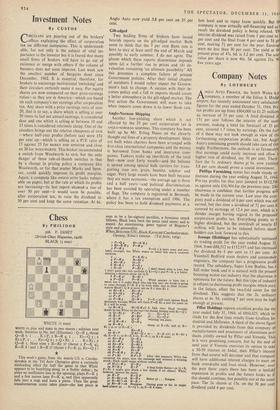Chess
By PHILIDOR 208. F. JANET
(British Chess Magazine, 1918) BLACK (5 men)
WHITE (6 men)
WHITE to play and mate in two moves ; solution next week. Solution to No. 207 (Ellennan) : Q-B 5, threat Q-B 7. I . . . K x P, 2 B-R 4. I . . . Kt-Q 5; 2 Kt xP. a . . . Kt-Q 6;z Qx Kt. a . . . R x Kt ; 2 Q-B a. Note tries a B-Kt a? (threat 2 P-K 4), R-K 8 ! and a B-B a? (threat 2 P-K 3), Kt-Q 5 l This week's game, from the match US v. Czecho- slovakia at the Tel Aviv Olympics gives a curiously misleading effect for half the game in that White appears to be bumbling along to a feeble defeat ; he plays an inoffensive line in the opening, plays P-K 3 and a few moves later P-K 4, and then apparently falls into a trap and loses a piece. Then the great transformation scene takes place-the lost piece is
seen to be a far-sighted sacrifice, a ferocious attack follows, Black loses back the piece (and more) and is mated. An entertaining game typical of Bisguier's style and personality.
White, BISGUIER(US). Black, KAVALEK (Czechoslovakia). Opening, KING'S Imam. (Tel Aviv, 1964).
1 P-$4 Kt-K B 3 2 Kt- B 3 P-B 4 ' 3 P-K 3 - . P-Q 5 is more usua; and pro- bably stronger, but White wants to avoid this much analysed variation.
P-K Kt 3 4 P-B 4 B-Kt z 3 Kt-B 3 0-0 6 B-K 2 P-Q 3
7 0-0 P-Kt 3 I don't know what is beat, but I don't quite like this: perhaps Q Kt-Q 2 and P-K 4 is better delaying a decision about the Q11. 8 P-I ‘ 41 B-Kt 2 9 P-g ;y P-K 4 White appears to have lost a move, but it is really Black who has lost one: the break is going to come through P-K B 4 by both sides and in these circum- stances Black's Q B is more usc on B x than Kt 2. ro Kt-K: Kt-Kr
11 Kt-Q3 P-8 4 rz PxP PxP
13 P-B 4 9_K2 P-K 5 will react against Black ultimately because, White will force P-K Kt 4 and the pawn on K $ will be weak. 14 B-K 3 BQ R 3? A fatal idea: Black wrongly thinks he has White on the run-he should develop with Kt-Q 2 13 Q-Kt 31 P x PP es . . . Kt-Q 23 r6 Bx P B x Kt? 16 ... Kt-Q 21 1.7 § x B Q x B 'winning' his piece.
18 R-K r Q-R 4
79 R-83 . . . threat 20 R x Kt . and zr R- Kt 3 ch or zo R-K 7.
Kt-B3
zo B x P Q Kt-Q 2 an. . R-B z??; at R-Kt 3 di, K-R t; 22 R-K 8 ch, R-B 1; 23 R x R mate. az Kt-B 4 §-R 3 22 R-83 -Kt 4
23 Kg-K6 -Kt 3
34 R-Kt 3 Kt-Kt 5
23 Bx R KtxB 26 P-K R 3 P-R 4
27 P x Kt R P xP After this massacre White has recovered his piece, won the exchange and retained a winning attack; Black could resign without undue risk.
28 R(3)-K3 Q--R3
29 R-K 5 B x P A final feeble flutter-3o Q x B, P-Kt 6 might give Black slew checks if no chance. White, however, ignores the move.
3o R x P BxQP
31 R-Kt 3 ch K-B a Better 3! ... Resigns. 32 R-Kt 7 ch K-K r • 33 Kt--B 7 ch Resist's. Having gone so far, he might hove played 33 ... K-Q z; 34 R-K 8 mate.




























 Previous page
Previous page